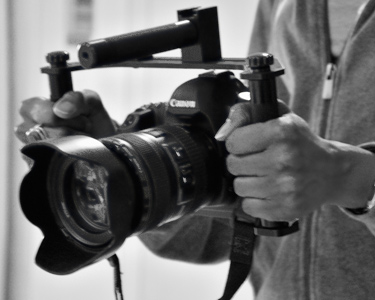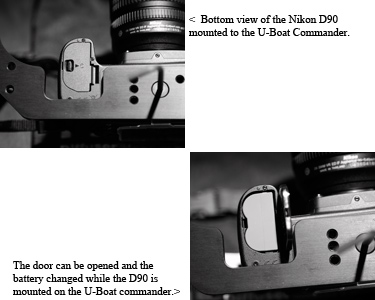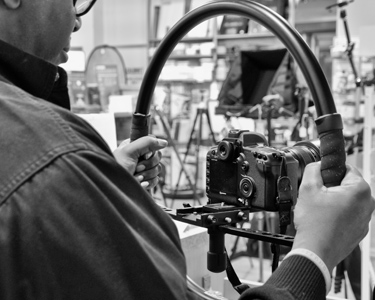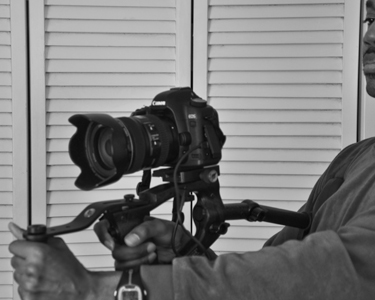One of the most significant products that I have come across in my examination of stabilizers for hslrs is the U-Boat Commander. The Commander, as I will refer to it, is an innovative product developed by photographer/director Bruce Dorn, a Canon Explorer of Light, writer, and gadgeteer extraordinaire. I call him a gadgeteer because Bruce has a wonderful ability to craft solutions to meet his shooting needs. A visit to his site www.idcphotography.com/blog/ is extremely enlightening.
I consider the Commander significant because it is, to my knowledge, the first stabilizing rig developed from scratch to accommodate the Canon 5D Mark II for video capture. The other rigs which I looked at were existing products. I have had use of the Commander for the last five days, and I will admit that as I boxed it up this morning to send it back to Arizona, there was a bit of mist in my eyes. Nikon D90 users do not feel slighted: I encourage you to read on.

Canon 5D Mark II mounted on the U-Boat Commander
The Commander offers something for lots of people due to its modular nature: In its most basic form it is a two-handled platform; the intermediate configuration adds a plate on top (bridge) as well as a handle and cold shoes, which allows you to mount a microphone and/or lights, as well as facilitating low angle shooting; and in its most complete form it adds a shoulder stabilizer, which can also aid in table top stabilization and or panning and tilting movements.) The anodized aluminum plates and bars are beautifully finished. I do want to note that the knurled handle grips come without handle pads: They will take standard bike handle grips (I used weightlifting grips.)
In many respects, the Commander reminded me of shooting with the Fig Rig, in that the unit is held out in front of you and the body acts as a shock absorber when moving. I also found that there was tremendous mobility although the Fig Rig does enjoy an edge here due to the circular frame. Unlike the Fig Rig, since the bottom plate of the Commander is flat, the camera can be safely placed on a flat surface when not in use. The 5D Mark II can be mounted directly to the commander base or attachment can be achieved via an optional quick release assembly. Either way, you have access to the 5D Mark II battery door.  For those shooting with the Nikon D90, the battery door of the camera is also fully accessible when it is mounted to the Commander base.
For those shooting with the Nikon D90, the battery door of the camera is also fully accessible when it is mounted to the Commander base.
The modular nature of the Commander brings together the best aspects of many of the other products I own/have used and/or considered, both less expensive and more expensive. It offers good range of motion, and shoulder stabilization on demand, the ability to mount accessories such as lights, microphones and monitors. The low angle shooting ability is a functionality that can be very costly with other systems.

Low angle shooting with the Commander
I found setting up the Commander pretty intuitive. There is, however, an excellent video demonstration on Bruce’s site for those who want an understanding of how all the pieces fit and work together. While I spent most of the time with the Commander in the intermediate configuration (Kit 2) with the bridge and handle attached, there is a lot to be said for attaching the shoulder stabilizer. I found it much easier to access camera controls while moving around with the shoulder stabilizer than without it. I liked the option of being able to use the stabilizer either over my shoulder or pressed into my shoulder. I also “pimped” the Commander and discovered that with the addition of small furniture gliders on the bottom of the base plate that I could achieve similar action to a dolly and track system on flat surfaces.
As I was mulling over my thoughts, I realized that most equipment reviews/commentary are written by men. I asked my sister to try the stabilizers out and share her reactions. Of the three pieces of equipment, her hands down favorite was the Commander. For her use, the Commander offered the best balance, was lighter than it looked and than she thought it would be, and she liked the over the shoulder stabilization option as opposed to the into the shoulder bracing.
The Commander kits are not inexpensive: While the intermediate configuration (Kit 2) exceeded the $300 budget I set by $69, the basic configuration (Kit 1) at $239 would have been within the parameters. The Works (Kit 3) would have been way out of range. The good news is that very soon there will be upgrade modules available for purchasers of Kits 1 and 2 so that you can add on as you need to and/or grow.
In looking at the options for products, I always suggest to the extent possible that consumers not only look at how they think they are going to use a product, but to try to look at the versatility and the range of applications for which a particular product can be adapted or used. I think that this is the most appropriate way to consider a tool like the U-Boat Commander. When I look at its functionality, and modular nature relative to the universe of available tools and add ons, the U-Boat Commander looks very, very good.
Don’t be surprised if you see one of my cameras mounted to my own Commander in the near future!
 What do you get when you mount a camera inside a steering wheel? You get a Fig Rig!! I keep hearing the Joni Mitchell song “Big Yellow Taxi” every time I think about the Fig Rig! People may find the concept of walking around holding a “steering wheel” in front of you, strange but I have to tell you it works. The Fig Rig offers incredible freedom of movement. The two handed navigation if you will, results in tremendous stability and smooth shooting. The body acts as the shock absorber and does not transfer the jarring movement to the Fig Rig. The wheel itself can accommodate add on’s such as video lights or a microphone using the optional Fig Rig clamp.
What do you get when you mount a camera inside a steering wheel? You get a Fig Rig!! I keep hearing the Joni Mitchell song “Big Yellow Taxi” every time I think about the Fig Rig! People may find the concept of walking around holding a “steering wheel” in front of you, strange but I have to tell you it works. The Fig Rig offers incredible freedom of movement. The two handed navigation if you will, results in tremendous stability and smooth shooting. The body acts as the shock absorber and does not transfer the jarring movement to the Fig Rig. The wheel itself can accommodate add on’s such as video lights or a microphone using the optional Fig Rig clamp.



You must be logged in to post a comment.